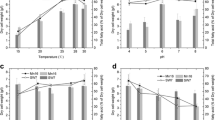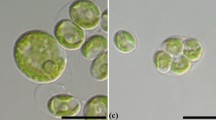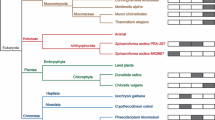Abstract
A marine microbe (strain SR21) from the coral reef area of the Yap Islands was isolated by a screening test for polyunsaturated fatty acids and was found to accumulate lipid that contained 22:5n-6 docosapentaenoic acid (DPA) as well as 22:6n-3 docosahexaenoic acid (DHA). Strain SR21 was identified as genusSchizochytrium in Labyrinthulomycota, owing to its ultrastructural character and life cycle, which is composed of vegetative cell, zoosporangium, and zoospore stages. After cultural optimization, both in flask and fermenter, the highest DHA and DPA productivities of 2.0 and 0.44 g/L per day, respectively, were obtained in a medium of 60 g/L glucose and corn steep liquor/ammonium sulfate in a half salt concentration of seawater in fermenter culture at 28°C and pH 4. This productivity was almost twice that obtained with flask culture, indicating its high resistance to mechanical stirring. The lipid extracted from the cell was about 50% of the dry cell weight and was composed of 93% triacylglycerol (TG). DHA content of the lipid was 34% of total fatty acids. The TG profile was simple, and the content of the most dominant TG, 1,3-dipalmitoyl-2-DHA-TG, was 27%. TG that contained DHA and n-6-DPA amounted to 57 and 17%, respectively, of total TG molecules. Strain SR21 was revealed to be an excellent source of microbial DHA and n-6 DPA.
Similar content being viewed by others
References
Dyerberg, J., H.O. Bang, E. Stofferson, S. Moncada, and J.R. Vane, Eicosapentaenoic Acid and Prevention of Thrombosis and Atherosclerosis?,Lancet 2:117–119 (1978).
O’Brien, J.S., and E.L. Sampson, Fatty Acid and Fatty Aldehyde Composition of the Major Brain Lipids in Normal Human Gray Matter, White Matter, and Myelin,J. Lipid Res. 6:545–551 (1965).
Nuringer, M., W.E. Conner, C.V. Petten, and L. Barstad, Dietary Omega-3 Fatty Acid Deficiency and Visual Loss in Infant Rhesus Monkeys,J. Clin. Invest. 73:272–276 (1984).
Bazan, N.G., T.S. Reddy, H.E.P. Bazan, and D.L. Birkle, Metabolism of Arachidonic and Docosahexaenoic Acids in the Retina,Prog. Lipid Res. 25:595–606 (1986).
Uauy, R.D., D.G. Birch, E.E. Birch, J.E. Tyson, and D.R. Hoffman, Effect of Dietary Omega-3 Fatty Acids on Retinal Function of Very-Low-Birth-Weight Neonates,Pediatr. Res. 28:485–492 (1990).
Sandra, N., A. Gharib, M. Croset, P. Moliere, and M. Lagarde, Fatty Acid Composition of the Rat Pineal Gland. Dietary Modifications,Biochim. Biophys. Acta. 1081:75–78 (1991).
Li, Z.Y., and O.P. Ward, Production of Docosahexaenoic Acid byThraustochytrium roseum, J. Indust. Microb. 13:238–241 (1994).
Bajpai, P., P.K. Bajpai, and O.P. Ward, Production of Docosahexaenoic Acid byThraustochytrium aureum, Appl. Microbiol. Biotechnol. 35:706–710 (1991).
Bajpai, P.K., P. Bajpai, and O.P. Ward, Optimization of Production of Docosahexaenoic Acid (DHA) byThraustochytrium aureum ATCC 34304,J. Am. Oil Chem. Soc. 68:508–514 (1991).
Kendrick, A., and C. Ratledge, Lipids of Selected Molds Grown for Production of n-3 and n-6 Polyunsaturated Fatty Acids,Lipids 27:15–20 (1992).
Yano, Y., A. Nakayama, H. Saito, and K. Ishihara, Production of Docosahexaenoic Acid by Marine Bacteria Isolated from Deep Sea Fish,29:527–528 (1994).
Kyle, D.J., V.J. Sicotte, J.J. Singer, and S.E. Reeb, Bioproduction of Docosahexaenoic Acid (DHA) by Microalgae, inIndustrial applications of Single Cell Oils, edited by D.J. Kyle and C. Ratledge, American Oil Chemists’ Society, Champaign, 1992, pp. 287–300.
Barclay, W.R., Process for the Heterotrophic Production of Microbial Products with High Concentrations of Omega-3 Highly Unsaturated Fatty Acids, U.S. Patent 5,130,242 (1992).
Barclay, W.R., Process for Growing Thraustochytrium Using Nonchloride Salts to Produce a Microfloral Biomass Having Omega-3 Highly Unsaturated Fatty Acids, U.S. Patent 5,340,742 (1994).
Iida, I., T. Nakahara, T. Yokochi, Y. Kamisaka, H. Yagi, M. Yamaoka, and O. Suzuki, Improvement of Docosahexaenoic Acid Production in a Culture ofThraustochytrium aureum by Medium Optimization,J. Ferm. Bioeng. 81:76–78 (1996).
The Lipid Handbook, edited by F.D. Gunstone, J.L. Harwood, and F.B. Padley, Chapman & Hall, London, 1994, pp. 173–175.
Homayoun, P., G. Durand, G. Pascal, and J.M. Bourre, Alteration of Fatty Acid Composition of Adult Rat Brain Capillaries and Choroid Plexus Induced by a Diet Deficient in n-3 Fatty Acids: Slow Recovery After Substitution with a Nondeficient Diet,J. Neurochem. 51:45–48 (1988).
Bourre, G.M., G. Durand, G. Pascal, and A. Youyou, Brain Cell and Tissue Recovery in Rats Made Deficient in n-3 Fatty Acids by Alteration of Dietary Fat,J. Nutr. 119:15–22 (1989).
Dyer, J.R., and C.E. Carol, Neural 22-Carbon Fatty Acids in the Weanling Rat Respond Rapidly and Specifically to a Range of Dietary Linoleic to Alpha-Linolenic Fatty Acid Ratio,J. Neurochem. 56:1921–1931 (1991).
Guesnet, P., G. Pascal, and G. Durand, Effects of Dietary Alpha-Linolenic Acid Deficiency During Pregnancy and Lactation on Lipid Fatty Acid Composition of Liver and Serum in the Rat,Reprod. Nutr. Dev. 28:275–292 (1988).
Ellenbogen, B.B., S. Aaronson, S. Goldstein, and M. Belsky, Polyunsaturated Fatty Acids of Aquatic Fungi: Possible Phylogenetic Significance,Comp. Biochem. Physiol. 29:805–811 (1969).
Harvey, D.J., Picolinyl Derivatives for the Structural Determination of Fatty Acids by Mass Spectrometry: Applications to Polyenoic Acids, Hydroxy Acids, Di-Acids and Related Compounds,Biomed. Mass Spectrom. 11:340–347 (1984).
Draffan, G.H., R.N. Stillwell, and A. McCloskey, Electron Impact-Induced Rearrangement of Trimethylsilyl Groups in Long-Chain Compounds,Org. Mass Spectrom. 1:669–685 (1968).
Johnson, C.B., and R.T. Holman, Mass Spectrometry of Lipids. 2. Monoglycerides, Their Diacetyl Derivatives and Their Trimethylsilyl Ethers,Lipids 1:371–380 (1966).
Findlay, R.H., J.W. Fell, N.K. Coleman, and J.R. Vestal, Biochemical Indications of the Role of Fungi and Thraustochytrids in Mangrove Detrtal Systems, inThe Biology of Marine Fungi, edited by S.T. Moss, Cambridge University Press, 1986, pp. 91–103.
Amon, J.P., Growth of Marine Chytrids at Ambient Nutrient Levels, inThe Biology of Marine Fungi edited by S.T. Moss, Cambridge University Press, 1986, pp. 69–80.
Raghkumar, S., and R. Balasubramanian, Occurrence of Thraustochytrid Fungi in Corals and Coral Mucus,Ind. J. Marine Sci. 20:176–181 (1991).
Guerriero, A., M. D’Ambrosio, F. Peitra, O. Ribes, and D. Duhet. Hydroxyeicosatetraenoic, Hydroxyeicosapentaenoic, Hydroxydococosapentaenoic, and Hydroxydococosahexaenoic Acids from the SpongeEchinochalina mollis of the Coral Sea,J. Nat. Prod. 53:57–61 (1990).
Guesnet, P., G. Pasval, and G. Durand, Effects of Dietary Alpha-Linolenic Acid Deficiency During Pregnancy and Lactation on Lipid Fatty Acid Composition of Liver and Serum in the Rat,Reprod. Nutr. Dev. 28:275–292 (1988).
Kramer, T.R., M. Briske-Anderson, S.B. Johnson, and R.T., Holman, Polyunsaturated Fatty Acid Patterns in Lymphoid and Nonlymphoid Tissues of Zinc-Deficient and Pair-Fed Rats,Nutr. Res. 6:1063–1074 (1986).
Hamm, W.M., V. Chan, and G. Wolf, Liver Microsomal Membrane Fluidity and Lipid Characteristics in Vitamin A-Deficient Rats,Biochem. J. 245:907–910 (1987).
Kyrklund, T., P. Kjellstrand, and K.G. Haglid, Effects of Exposure to Freon 11, 1,1,1-Trichloroethane or Perchloroethylene on the Lipid and Fatty-Acid Composition of Rat Cerebral Cortex.Scand. J. Work. Environ. Health 14:91–94 (1988).
Makino, Y., H. Matsuki, and Y. Suzuki, Pharmaceuticals Permeable to Blood-Brain Barrier, Japan Patent JP 61,204,136 (IPC A61K-047/00) (1985).
DeLong, E.F., and A. Yayanos, Biochemical Function and Ecological Significance of Novel Bacterial Lipids in Deep Sea Procaryotes,Appl. Environ. Microb. 51:730–737 (1986).
Gellerman, J.L., and H. Schlenk, Methyl-Directed Desaturation of Arachidonic to Eicosapentaenoic Acid in the Fungus,Saprolegnia parasitica, Biochim. Biophys. Acta 573:23–30 (1979).
Shimizu, S., Y. Shimmen, H. Kawashima, K. Akimoto, and H. Yamada, Fungal Mycelia as a Novel Source of Eicosapentaenoic Acid Activation of Enzyme(s) Involved in Eicosapentaenoic Acid Production at Low Temperature,Biochem. Biophys. Res. Commun. 150:335–341 (1988).
Author information
Authors and Affiliations
About this article
Cite this article
Nakahara, T., Yokochi, T., Higashihara, T. et al. Production of docosahexaenoic and docosapentaenoic acids bySchizochytrium sp. isolated from Yap Islands. J Am Oil Chem Soc 73, 1421–1426 (1996). https://doi.org/10.1007/BF02523506
Received:
Accepted:
Issue Date:
DOI: https://doi.org/10.1007/BF02523506




